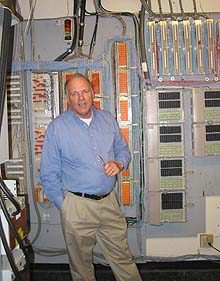|
July 12, 2004
Small antennas planned to improve cell phone
reception on campus
By Louise Donahue
Cell phone users frustrated by poor reception on campus may be getting
some help, thanks to an unusual public-private partnership.
|
The campus community is invited to attend an informational
meeting about the microcell project at noon on August 12 in Conference
Room D of the Bay Tree Building.
|

UCSC telecommunications manager Ed Titus said the new antennas
would be linked to land lines at the Communications Building via
UCSC's fiber optic lines.
Photo: Louise Donahue |
UCSC is working with Milpitas-based NextG
Networks to augment the three existing cell phone transmission antennas
north of Crown College with several microcellular antennas.
The project is designed to provide coverage to residence halls and
apartments as well as Science Hill and the base of campus.
Six microcellular antennas are expected to be installed at Porter College,
College Eight, Cowell College, Science Hill, and at the base of the
campus with additional antennas to be added later, if needed.
UCSC's wooded and hilly terrain makes cell phone reception a challenge,
because cell phone signals travel primarily in a "line of sight"
mode.
Efforts are being made to locate the antennas in the least obtrusive
places possible, and UCSC telecommunications manager Ed Titus has been
meeting with representatives of the affected colleges about where the
antennas would go. The microcellular antennas are generally placed in
an enclosure resembling a smokestack, and the entire unit is no more
than six feet tall.
"The microcells are much smaller, and much lower power, but they
are also lower in range," said Titus. Because of these limitations,
the antennas would be linked to land lines at the Communications Building
via UCSC's fiber optic lines.

One antenna is proposed for the Cowell College Academic Building.
|
"NextG will not charge us to install these antenna sites,"
said Titus. "In fact, they will pay us for the fiber optic circuits
they use. If we wanted to do this on our own, it would cost hundreds
of thousands of dollars."
Once the system is established, cell phone vendors would be expected
to lease equipment space in the Communications Building, bringing in
additional revenue, he said.
NextG has exclusive rights to market the campus network and has already
signed up Cingular. A key benefit of the arrangement is that it could
serve multiple cell-phone vendors, avoiding the problem of having separate
antennas to serve each vendor, Titus explained.
NextG Networks, which describes itself as a “next-generation”
wireless communications company, specializes in installing small antennas
“in places where aesthetics are important, but cell phone coverage
is terrible,” said Titus.
“This would be a big boon for the westside,” said Titus.
“We get calls from parents, and some students e-mail me each month
wanting to know our progress on this.”
While those involved in the project see many advantages for the campus,
they also want to give members of the campus community an opportunity
to air any concerns and ask questions. A public meeting will be held
at noon on August 12 at Conference Room D of the Bay Tree Building.
In the past, efforts to add large transmitters have prompted concerns
about radiation and the potential for the system to interfere with research
equipment. The use of smaller transmitters—35 watts as opposed
to 1,500 watts—may ease that concern, but everyone involved is
encouraging input.
“The project will not go ahead until all the bases have been covered,”
said project manager Courtney Grazian of Physical Planning and Construction.
Grazian said the Planning Department, and its Environmental Assessment
Group, will review the location of the antennas.
“We want to make certain that the campus community is very aware
of what’s going on,” said Ken Smith, radiation safety officer
for Environmental Health and Safety. “Everyone’s got a different
take on this.”
Allowable levels of exposure to radio frequency radiation are set by
the Federal Communications Commission, with one standard for the public
and another for workers. The level of allowable public exposure to transmitters
is about five times less than the occupational level, Titus said. The
microcellular antennas planned for UCSC are designed to emit less than
1 percent of that lower allowable public exposure level, Titus said.
Despite the low levels, the campus Radiation Safety Committee will
review the project as an additional precaution because of the proximity
to residences. Ordinarily, the committee does not review projects unless
they reach the threshold of 10 percent of the allowable public exposure
level. Environmental Health and Safety will also review NextG’s
reports on radio frequency exposure to be sure everything checks out,
Smith said.
“Once they get the information, most people are assured they’re
safe,” said Smith. “I’d rather see this model than a
large transmitter.”
Additional information
Several web sites include background on radio frequencies and related
issues.
The Health Physics Society web site
has an extensive "Ask the Experts" section which includes
detailed answers to questions such as Is
there any risk for health with the installation of a cellular tower
near a community? (answered by Gary H. Zeman of Lawrence Berkeley
National Laboratory) and Is
there any standard for a distance between a cellular base station and
residential area? (answered by Kenneth R. Foster of the University
of Pennsylvania).
The Federal Communications Commission web site also includes
Questions on radio frequency safety and a listing of
FCC actions and proposals relating to radio frequency safety issues.
Return to Front Page
|